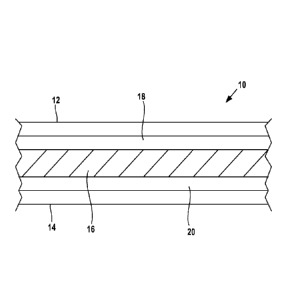Some of the information on this Web page has been provided by external sources. The Government of Canada is not responsible for the accuracy, reliability or currency of the information supplied by external sources. Users wishing to rely upon this information should consult directly with the source of the information. Content provided by external sources is not subject to official languages, privacy and accessibility requirements.
Any discrepancies in the text and image of the Claims and Abstract are due to differing posting times. Text of the Claims and Abstract are posted:
| (12) Patent: | (11) CA 2904036 |
|---|---|
| (54) English Title: | REFLECTIVE INSULATION |
| (54) French Title: | ISOLATION REFLECHISSANTE |
| Status: | Granted |
| (51) International Patent Classification (IPC): |
|
|---|---|
| (72) Inventors : |
|
| (73) Owners : |
|
| (71) Applicants : |
|
| (74) Agent: | MACRAE & CO. |
| (74) Associate agent: | |
| (45) Issued: | 2022-11-01 |
| (86) PCT Filing Date: | 2014-02-27 |
| (87) Open to Public Inspection: | 2014-09-12 |
| Examination requested: | 2018-12-21 |
| Availability of licence: | N/A |
| (25) Language of filing: | English |
| Patent Cooperation Treaty (PCT): | Yes |
|---|---|
| (86) PCT Filing Number: | PCT/US2014/018824 |
| (87) International Publication Number: | WO2014/137715 |
| (85) National Entry: | 2015-09-03 |
| (30) Application Priority Data: | ||||||
|---|---|---|---|---|---|---|
|
A reflective insulation includes a first layer and a second layer, the first layer being a reflective layer and the second layer being an insulation layer. An activated heat seal film between and in contact with the first and second layers adheres the first and second layers together. The Zupon et al. reflective insulation includes a reflective layer A (which reflective layer may be formed from aluminum), an insulation layer B formed of fiberglass, and a vapor barrier layer C (which vapor barrier layer may be formed from plastic or a reflective material such as the aluminum).
L'invention concerne une isolation réfléchissante qui comprend une première couche et une seconde couche, la première couche étant une couche réfléchissante et la seconde couche étant une couche d'isolation. Un film thermoscellable activé entre et en contact avec les première et seconde couches colle ensemble lesdites première et seconde couches. L'isolation réfléchissante de Zupon et alii comprend une couche réfléchissante A (laquelle couche réfléchissante peut être constituée d'aluminium), une couche d'isolation B constituée de fibre de verre et une couche pare-vapeur C (laquelle couche pare-vapeur peut être constituée d'un plastique ou d'un matériau réfléchissant comme l'aluminium).
Note: Claims are shown in the official language in which they were submitted.
Note: Descriptions are shown in the official language in which they were submitted.

For a clearer understanding of the status of the application/patent presented on this page, the site Disclaimer , as well as the definitions for Patent , Administrative Status , Maintenance Fee and Payment History should be consulted.
| Title | Date |
|---|---|
| Forecasted Issue Date | 2022-11-01 |
| (86) PCT Filing Date | 2014-02-27 |
| (87) PCT Publication Date | 2014-09-12 |
| (85) National Entry | 2015-09-03 |
| Examination Requested | 2018-12-21 |
| (45) Issued | 2022-11-01 |
There is no abandonment history.
Last Payment of $125.00 was received on 2024-02-22
Upcoming maintenance fee amounts
| Description | Date | Amount |
|---|---|---|
| Next Payment if standard fee | 2025-02-27 | $347.00 |
| Next Payment if small entity fee | 2025-02-27 | $125.00 |
Note : If the full payment has not been received on or before the date indicated, a further fee may be required which may be one of the following
Patent fees are adjusted on the 1st of January every year. The amounts above are the current amounts if received by December 31 of the current year.
Please refer to the CIPO
Patent Fees
web page to see all current fee amounts.
| Fee Type | Anniversary Year | Due Date | Amount Paid | Paid Date |
|---|---|---|---|---|
| Application Fee | $200.00 | 2015-09-03 | ||
| Registration of a document - section 124 | $100.00 | 2015-12-04 | ||
| Maintenance Fee - Application - New Act | 2 | 2016-02-29 | $50.00 | 2015-12-31 |
| Maintenance Fee - Application - New Act | 3 | 2017-02-27 | $50.00 | 2016-10-25 |
| Maintenance Fee - Application - New Act | 4 | 2018-02-27 | $50.00 | 2017-12-28 |
| Maintenance Fee - Application - New Act | 5 | 2019-02-27 | $100.00 | 2018-11-14 |
| Request for Examination | $400.00 | 2018-12-21 | ||
| Maintenance Fee - Application - New Act | 6 | 2020-02-27 | $100.00 | 2020-02-26 |
| Maintenance Fee - Application - New Act | 7 | 2021-03-01 | $100.00 | 2021-01-08 |
| Maintenance Fee - Application - New Act | 8 | 2022-02-28 | $100.00 | 2022-02-09 |
| Final Fee | 2022-09-16 | $152.69 | 2022-08-17 | |
| Maintenance Fee - Patent - New Act | 9 | 2023-02-27 | $100.00 | 2022-12-08 |
| Maintenance Fee - Patent - New Act | 10 | 2024-02-27 | $125.00 | 2024-02-22 |
Note: Records showing the ownership history in alphabetical order.
| Current Owners on Record |
|---|
| INTERNATIONAL INSULATION PRODUCTS LLC |
| Past Owners on Record |
|---|
| None |